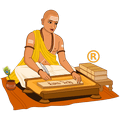























Sunrise06:46
Sunset18:16
Moonrise13:08
Moonset23:01
Shaka Samvat-3259 Siddharthi
Vikram Samvat-3124 Angira
Gujarati Samvat-3124 Prajapati
Amanta MonthMargashirsha
Purnimanta MonthMargashirsha
WeekdayShaniwara
PakshaShukla Paksha
TithiSaptami upto 00:00, Oct 06
NakshatraShatabhisha upto 13:07
YogaVajra upto 10:08
KaranaGaraja upto 12:53
KaranaVanija upto 00:00, Oct 06
Pravishte/Gate3
MoonsignKumbha upto 06:21, Oct 06
Rahu Kalam09:38 to 11:05
Gulikai Kalam06:46 to 08:12
Yamaganda13:57 to 15:23
Abhijit12:08 to 12:54
Dur Muhurtam06:46 to 07:32
Dur Muhurtam07:32 to 08:18
Amrit Kalam04:29, Oct 06 to 06:01, Oct 06
Varjyam19:16 to 20:48
Notes: All timings are represented in 24-hour notation in local time of Columbus, United States with DST adjustment (if applicable).
Hours which are past midnight are suffixed with next day date. In Panchang day starts and ends with sunrise.



 Vrishchika 25:33+
Vrishchika 25:33+ Jyeshtha 25:33+
Jyeshtha 25:33+

 Makara
Makara U Ashadha 18:25
U Ashadha 18:25

 Kumbha 30:21+
Kumbha 30:21+ Shatabhisha 13:07
Shatabhisha 13:07

 Meena
Meena P Bhadrapada 12:10
P Bhadrapada 12:10

 Meena
Meena U Bhadrapada 11:40
U Bhadrapada 11:40

 Meena 11:37
Meena 11:37 Revati 11:37
Revati 11:37

 Mesha 19:09
Mesha 19:09 Bharani 12:52
Bharani 12:52

 Vrishabha 28:49+
Vrishabha 28:49+ Rohini 15:49
Rohini 15:49

 Mithuna
Mithuna Mrigashira 17:55
Mrigashira 17:55

 Mithuna 16:28
Mithuna 16:28 Punarvasu 23:11
Punarvasu 23:11

 Karka
Karka Pushya 26:15+
Pushya 26:15+

 Simha
Simha Magha
Magha

 Simha
Simha Magha 08:32
Magha 08:32

 Simha 18:03
Simha 18:03 P Phalguni 11:24
P Phalguni 11:24

 Kanya
Kanya U Phalguni 13:48
U Phalguni 13:48

 Kanya 28:10+
Kanya 28:10+ Hasta 15:34
Hasta 15:34

 Tula
Tula Chitra 16:33
Chitra 16:33

 Tula
Tula Swati 16:43
Swati 16:43

 Vrishchika 12:42
Vrishchika 12:42 Jyeshtha 12:42
Jyeshtha 12:42

 Dhanu
Dhanu Mula 10:14
Mula 10:14

 Makara 12:27
Makara 12:27 Dhanishtha 23:11
Dhanishtha 23:11

 Kumbha
Kumbha Shatabhisha 20:57
Shatabhisha 20:57In Hindu Calendar, the day starts with local sunrise and ends with next day local sunrise. As sunrise time is different for all cities, Hindu Calendar made for one city is not valid for any other city. Hence it is important to use location based Hindu Calendar, like this website. Further, each Hindu day consists of five elements, which are called angas. These five elements are -
In Hindu Calendar, all five elements together are called Panchang. (In Sanskrit: Panchang = Pancha (five) + Ang (part)). Hence Hindu Calendar which shows all five elements for each day is called Panchang. In South India Panchang is known as Panchangam.
When Hindu Calendar includes Muslims, Sikh, Christian, Buddhist and Jain festivals, including national holidays, it is called as Indian Calendar.